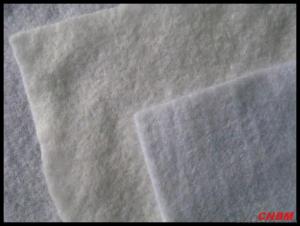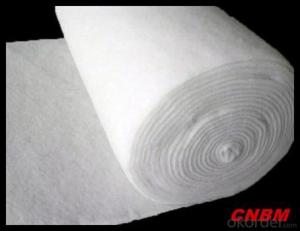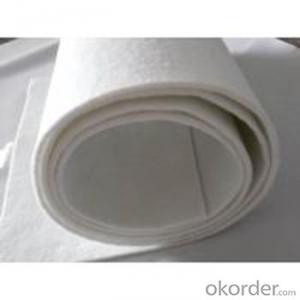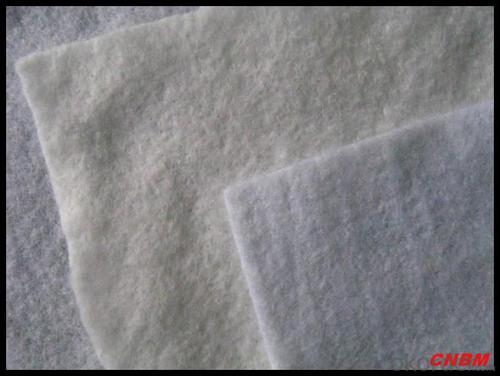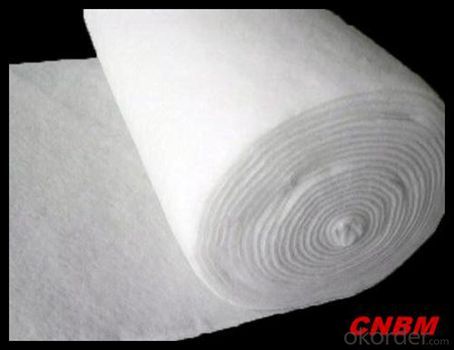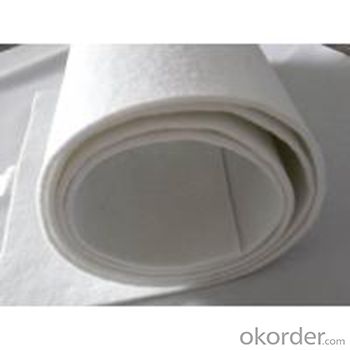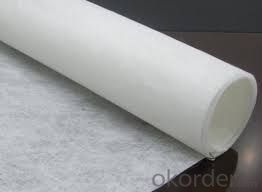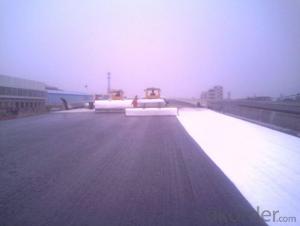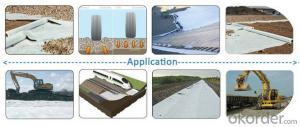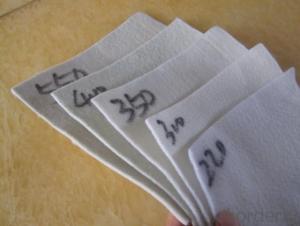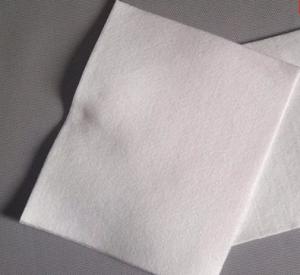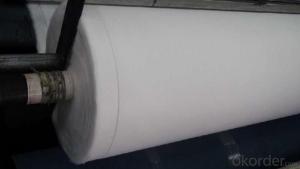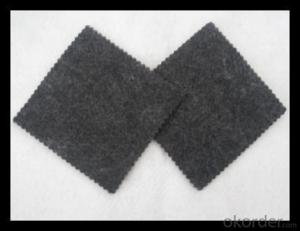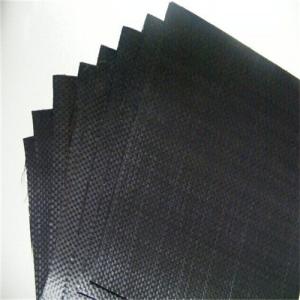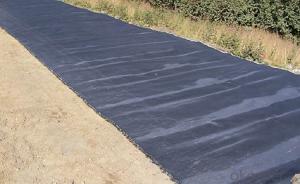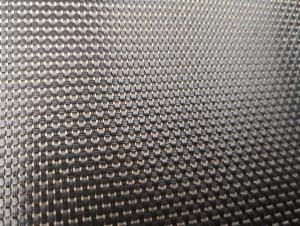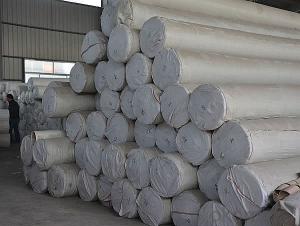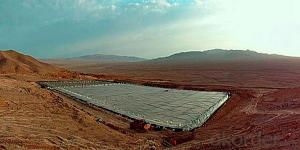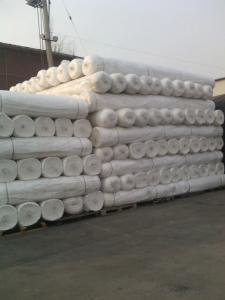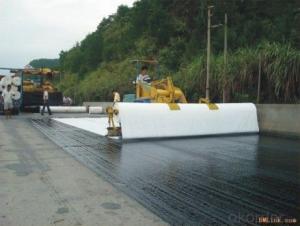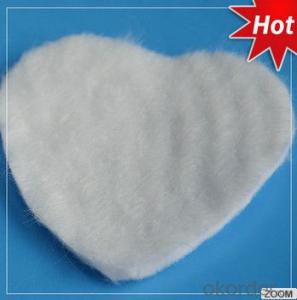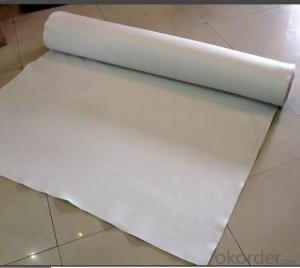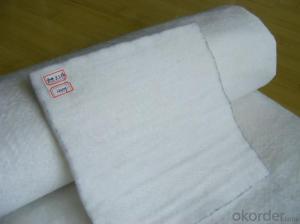Woven Stabilization Geotextile Fabric for Road Construction
- Loading Port:
- China main port
- Payment Terms:
- TT OR LC
- Min Order Qty:
- 1000 m²
- Supply Capability:
- 500000 m²/month
OKorder Service Pledge
OKorder Financial Service
You Might Also Like
Specification
| Project | 100 | 150 | 200 | 250 | 300 | 350 | 400 | 450 | 500 | 600 | 800 | Remarks |
| Mass per unit bias% | -8 | -8 | -8 | -8 | -7 | -7 | -7 | -7 | -6 | -6 | -6 | |
| Thickness≥ | 0.9 | 1.3 | 1.7 | 2.1 | 2.4 | 2.7 | 3.0 | 3.3 | 3.6 | 4.1 | 5.0 | |
| Breaking force≥ | 2.5 | 4.5 | 6.5 | 8.0 | 9.5 | 11.0 | 12.5 | 14.0 | 16.0 | 19.0 | 25.0 | |
| CBR bursting strenth ≥ | 0.3 | 0.6 | 0.9 | 1.2 | 1.5 | 1.8 | 2.1 | 2.4 | 2.7 | 3.2 | 4.0 | |
| Tearing force ≥ | 0.08 | 0.12 | 0.16 | 0.20 | 0.24 | 0.28 | 0.33 | 0.38 | 0.42 | 0.46 | .060 | |
| Width bias% | -0.5 | |||||||||||
| Elongation at break % | 25-1000.07-0.2 | |||||||||||
| EOS 090mm | ||||||||||||
| Coefficient of vertical permeability ,cm/s | k×(10-1~10-3) | K=1.0-9.9 | ||||||||||
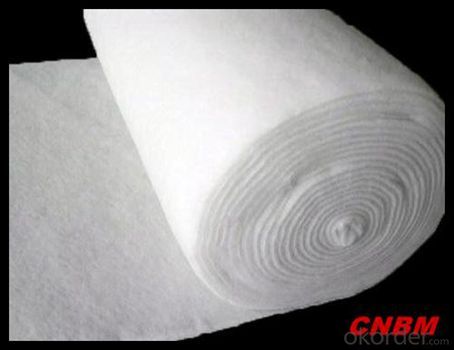
Non-woven Geotextile is widely used
in the areas of railway,highway,water conservancy,dam,tunnel,subway.
The major functions of Non-woven Geotextile: Separation, filtration, drainage, reinforcement, protection, and liquid barrier.
The geotextile can also be heat treated by infrared at customer's requirements. Our geotextile are UV stabilized to give protection against aging under exposure to natural ultra-violet light
Packaging & Shipping
Packing: PLASTIC FILM INSIDE, AND WOVEN BAG OUTSIDE
Shipping: About 15 days after receipt the deposit
pecifications
geotextile fabric
permeability,filtration,easy for construction
ISO and CE certificate
Good quality and competitive price
Our Service
Quality assurance
1.On a regular basis or as per your request,we entrust national testing agencies to conduct quality inspections
2. Strictly in accordance with the ISO9001-2008 international quality system standard,we monitor and manage the whole process throughout production,quality testing,and measurement to ensure product quality
3. For quality-related construction delay or substandard construction(except for damage or losses due to customer’s responsibility or irresistible natural disasters),we have refunding,replacement,and repair services.We will respond to customers’ feedbacks on quality issues within 24 hours.
After-sales service
1.In order to provide customers with comprehensive technical support,we will provide technical and other related information upon request in a timely manner.
2.In required,we will appoint specialized technicians to the construction site to give technical trainings to construction people,and offer technical guidance throughout the whole construction process.
3.For damage due to shipment and delivery,after we receive the complaint,we will check the issure through provided pictures and videos.If our responsibility is confirmed,we wil offer free replacement.
4.When the construction is completed,as your request,our technical staff may participate in the final acceptance.
FAQ:
Q: What kind of payments does jenor support?
A: T/T, L/C, Cash are accepted.
Q: Do you charge for the samples?
A: Accordeing to our company policy, the samples are free, we only charge the freight fee. And we will return the freight fee during the next order.
Q: Can you produce according to customers' design?
A: Sure, we are professional manufacturer, OEM and ODM are both welcome.
Q: Do you have other products?
A: Yes, please check the pictures:
- Q: How do geotextiles help with waste containment systems?
- Geotextiles help with waste containment systems by acting as a barrier and providing reinforcement. They prevent the migration of waste materials, such as landfill leachate or contaminated soil, by effectively separating and containing them within the system. Geotextiles also enhance the stability and durability of the containment system by distributing loads and reducing the risk of punctures or tears.
- Q: What are the key differences between woven and nonwoven geotextiles?
- The key differences between woven and nonwoven geotextiles lie in their manufacturing processes and physical properties. Woven geotextiles are created by interlacing individual yarns or fibers in a crisscross pattern, resulting in a stable and strong fabric. On the other hand, nonwoven geotextiles are manufactured by bonding or felting fibers together using mechanical, thermal, or chemical processes, resulting in a fabric with random fiber orientation. Woven geotextiles typically have higher tensile strength and puncture resistance due to their interlocked yarns, making them suitable for applications that require structural stability and load distribution. They are commonly used in road construction, erosion control, and soil stabilization projects. Nonwoven geotextiles, while generally having lower strength properties compared to their woven counterparts, offer advantages such as filtration, drainage, and separation functions. They are commonly used for filtration and separation in drainage systems, as well as in erosion control, landscape fabric, and geocomposite applications. Overall, the choice between woven and nonwoven geotextiles depends on the specific project requirements, such as load-bearing capacity, filtration needs, and budget considerations.
- Q: The difference between lap and stitching
- In terms of popularity, the lap is a kind of overlapping, overlapping with each other interface method; and seam law is not overlapping, the use of docking method, will inevitably leave the gap, so called seam method. These two methods are used for geotextile construction, the construction requirements: When the use of lap connection, lap length should be 0.3 ~ 0.9m, the use of seam method, the bonding width of not less than 50mm, bonding strength of not less than The tensile strength of the material. On-site construction of the upper and lower joints should be staggered, staggered length of not less than 0.5m.
- Q: How do geotextiles affect soil erosion rates?
- Geotextiles can significantly reduce soil erosion rates by acting as a protective barrier. They prevent soil particles from being washed away by water or blown away by wind, while still allowing water to pass through. This helps to stabilize the soil, improve its structural integrity, and promote vegetation growth, ultimately leading to a reduction in erosion rates.
- Q: How do geotextiles help with soil reinforcement in mechanically stabilized earth walls?
- Geotextiles help with soil reinforcement in mechanically stabilized earth walls by providing a strong and stable support system. They act as a barrier between the soil layers, preventing erosion and maintaining the integrity of the wall. The geotextiles distribute the load of the soil evenly, reducing the potential for settlement or failure. Additionally, they enhance the overall stability of the structure by increasing the friction between the soil layers, improving the resistance to lateral forces.
- Q: How do geotextiles help in gas venting?
- Geotextiles help in gas venting by allowing the passage of gases through their porous structure while preventing the migration of soil particles. These textiles are used as a barrier or filter to control the movement of gases, such as methane, in areas where gas buildup can be hazardous, such as landfills or contaminated sites. The geotextiles allow the gas to escape, reducing the risk of explosions or other safety hazards, while still providing stability and support to the surrounding soil.
- Q: What is geotextile? Its use
- Geotextile is a kind of non-woven fabric. Its use is the road moisturizing, dam protection, reinforcement, isolation.
- Q: Will the geotechnical cloth used for highway engineering, geogrid raw materials, routine testing items, parameters which?
- Geotextile main inspection items are: ① Tensile strength: In the tensile test, the specimen until the fracture until the maximum tensile stress is the tensile strength, known in the academic sense of tensile strength. ② elongation: elongation, that is, the percentage of the ratio of the total deformation to the length of the original gauge after the tensile fracture of the specimen. ③ tear strength: it is a thin film or thin film tear resistance of a test method defined in a term. This method is a tear test performed on a special testing machine with a specimen with a predetermined gap. ④ bursting strength ⑤ thickness ⑥ per unit area quality ⑦ permeability coefficient: permeability coefficient, also known as hydraulic conductivity. In an isotropic medium, it is defined as the unit flow rate per unit of hydraulic gradient, indicating the ease with which the fluid passes through the pore skeleton. Geogrids include: appearance, physical properties (including: mass per unit area, amplitude measurement, mesh size determination); mechanical properties (including: strip tensile test, joint / seam wide strip tensile test, sticky Solder joints)
- Q: Can geotextiles be used for reinforcement of underground tunnels?
- Yes, geotextiles can indeed be used for the reinforcement of underground tunnels. Geotextiles are flexible, permeable materials that can provide support, stability, and prevent soil erosion in various civil engineering applications, including tunnel construction. They can be placed to reinforce the surrounding soil and prevent movement or collapse, enhancing the structural integrity of the tunnel. Additionally, geotextiles can also act as a drainage layer, allowing water to flow through while minimizing soil saturation, which is crucial for long-term tunnel stability.
- Q: How do geotextiles help in stabilizing slopes for pipeline construction?
- Geotextiles help in stabilizing slopes for pipeline construction by providing reinforcement and erosion control. They are placed along the slope to prevent soil erosion and promote stability. The geotextiles act as a barrier, preventing the movement of soil particles and reducing the risk of slope failure. Additionally, they enhance the soil's strength and increase its resistance to erosion caused by water flow. Overall, geotextiles play a crucial role in maintaining the stability of slopes during pipeline construction.
Send your message to us
Woven Stabilization Geotextile Fabric for Road Construction
- Loading Port:
- China main port
- Payment Terms:
- TT OR LC
- Min Order Qty:
- 1000 m²
- Supply Capability:
- 500000 m²/month
OKorder Service Pledge
OKorder Financial Service
Similar products
Hot products
Hot Searches
Related keywords
